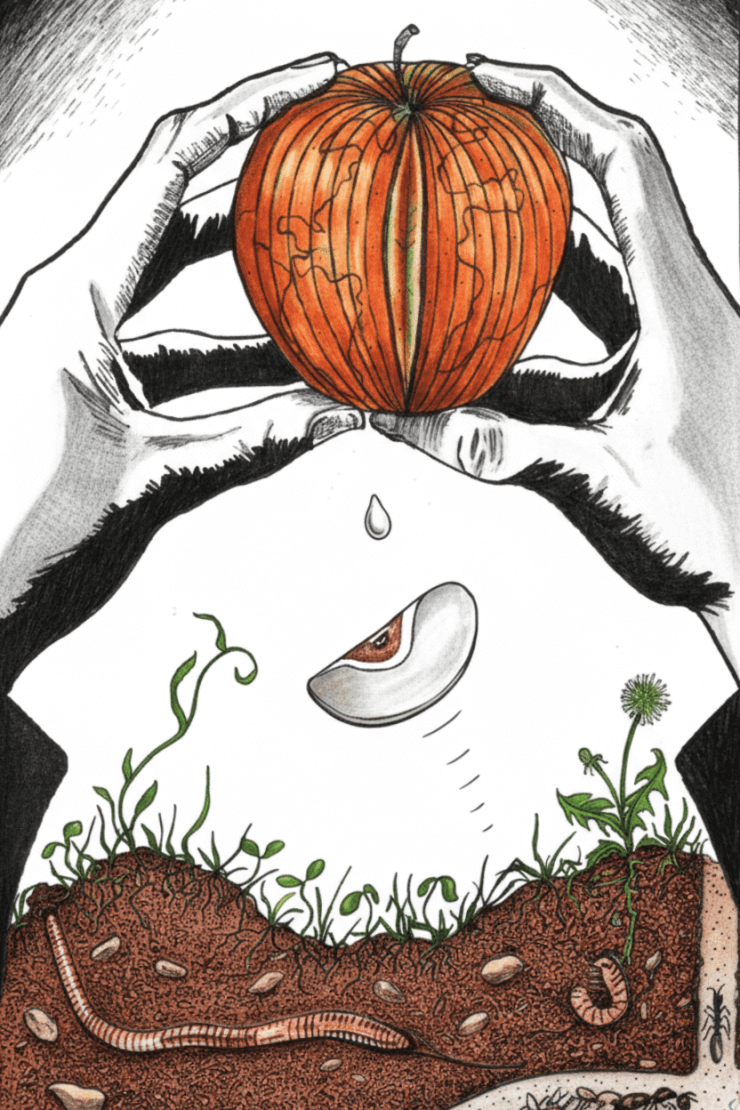Read by Matilda Longbottom

It’s amazing how few of us truly appreciate dirt. Look at the way we talk about it. Dirty thoughts are reprehensible; dirty linen is embarrassing; dirty tricks are mean. If something is deemed lowly and worthless, it’s said to be common as dirt; and to treat someone like dirt means indulging in some truly despicable behavior. We scrub it off the minute any gets on us, and we yell at people who track it in the house. Dirt is a shockingly under-respected commodity. After all, six inches of dirt is all that is between us and extinction. No dirt and we’re dead as doornails.
Furthermore, for all that there seems to be dirt all over the place, there actually isn’t that much of it. A friend who teaches third grade told me about a depressing dirt demonstration with an apple. Cut the apple in quarters, she said, and set three aside. These represent the three-quarters of the globe occupied by the world’s oceans. Slice the remaining quarter in half. One half represents land that’s essentially uninhabitable: people-unfriendly regions like Antarctica, the Sahara Desert, and the peaks of the Himalayas. Divide the other half—people territory, a mere one-eighth of the globe—into four pieces. Set three of these aside: These are all unsuitable for growing food, being too cold, too rocky, too wet, or inaccessible to gardeners, having been slathered over with houses, highways, skyscrapers, and parking lots. The final intimidatingly skinny slice—just one-thirty-second of the Earth’s Lota I surface area—is all we’ve got for dirt. That’s it: arable land, the teeny bit of the globe that all six billion of us depend upon for food.
I thought about this while looking out the kitchen window and eating the Pacific-Ocean portion of the apple. Out in the backyard, the kids were throwing a Frisbee. Get off that dirt, I thought.
I looked up dirt on the Internet and discovered that dirt isn’t just rare; it’s complicated. Luckily, it’s made for us, because we’d go bats if we had to cobble it together ourselves from scratch. To the uninitiated, dirt may look like grubby generic mush, but it actually has character, individuality, and a whole taxonomy all its own. Soil scientists recognize 12 major orders of dirt, each divided into suborders, groups, subgroups, families, and series, according to their various allotments of minerals and organic matter. Thus, around here the stuff that gets all over the knees of your overalls as you crawl around the tomato plants isn’t just dirt: It’s a spodosol, of the Suborder Orthods, Great Group Haplorthods, Typic Subgroup, Tunbridge Soil Series. Dirt has a pedigree. And here I’ve been stepping on it and digging holes in it.
Dirt doesn’t just sit there preening itself, however. It does stuff. We know this, because we know what happens when it malfunctions. For example, there’s the sobering story of Biosphere 2. Biosphere 2, a high-tech Crystal Palace planted in the Arizona desert, is the world’s biggest greenhouse. It was designed to reproduce in miniature Earth’s biosphere (the big one, Biosphere 1) and in its heyday, it was home to eight people and 3000 species of plants, animals, fish, and insects, all scattered over seven mini biomes, among them a pint-sized tropical rainforest, savannah, marsh, and even an ocean, simulated by a million-gallon saltwater aquarium. The concrete foundations underlying all of these were covered with dirt, 30,000 tons of it, mixed according to 30 different recipes. The theory was that all the Biosphere’s tiny ecosystems, with their resident populations of flora and fauna, would interact and equilibrate, eventually creating a stable and self-perpetuating Eden.
Instead, everything went to pot. Beneath the Biosphere’s glittery glass roof, carbon dioxide levels shot up, and oxygen levels dropped dangerously. Most of the animals and insects abruptly went extinct, except for the cockroaches and one particularly tough and annoying breed of ant. Crops failed. Soon the project, suffering from environmental meltdown, reached the point of no return. The prime culprits in this eco-fiasco turned out to be soil bacteria run amok, multiplying like mad things at indecent rates.
Biosphere 2 crashed because its soil recipes were wrong.
The biospherians were done in by dirt.
There are some things we’ re not much good at, and dirt appears to be one of them. The Earth does dirt better—even though it’s poky about it. According to one estimate, it takes up to 500 years to produce a single inch of topsoil. As awe-inspiring items go, however, compared to Stonehenge, say, or the Taj Mahal-dirt is low on the admiration totem pole. It just doesn’t look impressive—especially the brand in our garden which, despite all our pampering and compost, has a tendency to slump into flinty rubble. Still, every year we cram seeds into it and get back pumpkins, cucumbers, and zucchini, an annual richness of something out of practically nothing. That things grow strikes me as nothing short of miraculous. Dirt, properly viewed, can give you that whirly feeling of wonder you get when gazing up at the starry sky. The stuff beneath our sneaker soles is incredible. How lucky we are to have backyards full of it.
State legislatures, a garden-deprived crew whom I would have predicted to be totally oblivious to (real) dirt, have been surprisingly dirt-conscious. Just as we have state birds, trees, and flowers (and in some over-patriotic cases, state fish, dinosaurs, amphibians, cookies, and muffins) we also—by legislative decree—have state dirts. The Smithsonian has plans for assembling samples of these into a permanent display—a vast National Wall of Dirt, lining a hallway next to the Hope Diamond. It’s an apt juxtaposition. It would be nice to think that after some of the Smithsonian’s 24 million annual visitors gape at the 40-odd-carat Hope, they’ll take time to examine the really uncommon stuff.
After all, diamonds may be forever, but we’re not. And we’re only here now because of dirt. ❖


 Previous
Previous


